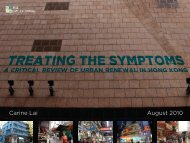Untitled - Civic Exchange
Untitled - Civic Exchange
Untitled - Civic Exchange
You also want an ePaper? Increase the reach of your titles
YUMPU automatically turns print PDFs into web optimized ePapers that Google loves.
SUSTAINABLE TRANSPORT IN HONG KONG: DIRECTIONS AND OPPORTUNITIES<br />
government was apparently promoting Route 10 as something that would be generally useful for a new<br />
port, wherever it might be located.<br />
On March 8, 2002, LegCo voted against the TB's request for HK$134 million to carry out detailed design<br />
for the northern section of Route 10, demanding that the TB reconsider its plan. Prior to the vote of LegCo's<br />
Finance Committee, the Transport Panel held numerous meetings to discuss the government's proposal and<br />
receive public deputations, most of which raised questions about the basis for many of the TB's<br />
assumptions. The fact that these kinds of critical issues were not raised until a late stage of the planning<br />
process indicates the failure of the CS and FS to pick up on key problems at an earlier date.<br />
The Route 7 controversy<br />
Controversy over Route 7 is ongoing, even though the plan for a highway from Kennedy Town to Lantau<br />
has been axed. The remaining portion of Route 7 was designed as a six-lane highway that would run from<br />
Kennedy Town to Aberdeen. 268 Public objection to the Route 7 plan is based primarily on the existence of<br />
a direct non-road transport alternative that is arguably more sustainable and cost-effective. The non-road<br />
alternative is a South Island Line (SIL) that would connect Aberdeen and Pokfulam to Central. 269 The SIL<br />
would provide faster, cleaner, and far more widely accessible transport for people in the area than the<br />
proposed highway. In addition, unlike Route 7, a SIL would be mostly self-financing. Based on engineering<br />
cost estimates for similar projects and projected ridership, it is estimated that the amount of government<br />
support needed for the new rail line would be under HK$5 billion and may well be under HK$4 billion,<br />
equal to less than half the cost of building Route 7.<br />
However, the TB's consultancy report showed that the provision of a rail line would only reduce the<br />
number of private cars and taxis on the road during peak hours by about 3%. This consultancy model was<br />
not based on a rail versus road comparison but on an old model, which considered whether local residents<br />
in the area who were private car owners and/or could afford regular taxi rides would use rail or not. 270 As<br />
such, the TB's study did not take into account factors such as relieving congestion in Central, convenience<br />
of a rail option for major population centers in Southern and Western Districts, and the potential for lowcost<br />
park and ride facilities at area stations. 271 A further flaw in the TB consultancy report was that no<br />
environmental assessment was done on air and noise impacts.<br />
In the debate over Route 7, the TB argued that "roads and railway are complementary to each other and<br />
one cannot always replace the other." 272 This argument failed to address the central question of whether a<br />
SIL would provide better service than a road in this particular area. The TB continues to argue that plans<br />
for a South Island rail line remain on the drawing board, despite the fact that building Route 7 will<br />
268 Plans for Route 7 have been scaled back due to public objections to the original design, which located the road<br />
along the shoreline, thereby destroying the natural beauty of the area and increasing air and noise pollution. The<br />
government was forced to agree to redesign the road to go through Mount Davis, submerging a section to reduce<br />
unsightliness. These measures would increase costs dramatically, putting the cost of the whole project in the region<br />
of about HK$10 billion. The TB also proposed to reduce the road to four lanes and extend only as far as the new<br />
Pokfulam Cyberport.<br />
269 The South Island Line (SIL) was discussed in RDS2 as a desirable but non-priority line.<br />
270 The TB's consultant assumed that 22% of households in the Route 7 catchment area own a car and that even<br />
with a rail option, relatively few of them would use rail to travel to the northern part of Hong Kong Island.<br />
Community groups lobbying for a rail option, such as SOS-Save Our Shorelines, found it difficult to have an open<br />
discussion with transport officials as the TB's dismissal of the feasibility of rail was based on this critical<br />
assessment.<br />
271<br />
Mathematical models are essential to decision-making. Yet all models rely on an extensive set of built-in<br />
assumptions, many of which may not even be evident to model users. The prudent user recognizes that the model's<br />
outputs must complement (not replace) critical human thinking on the part of the analysts.<br />
272 Transport Bureau (2001), personal communication to Christine Loh, Oct 26, 2001.<br />
84

















